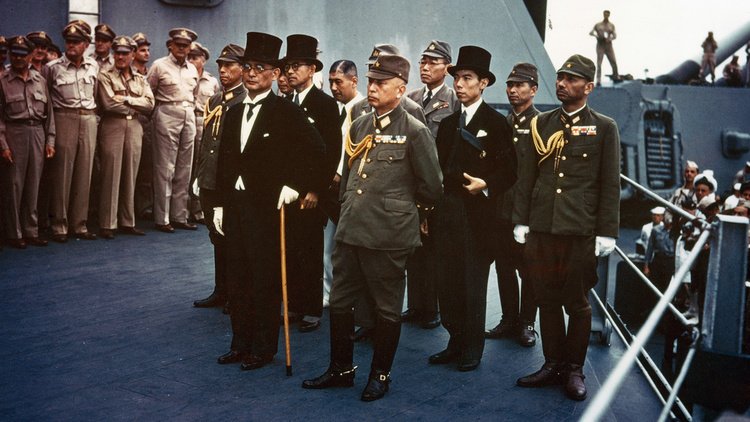This Day In History
Japan surrenders, bringing an end to WWII

Aboard the USS Missouri in Tokyo Bay, Japan formally surrenders to the Allies, bringing an end to World War II.
By the summer of 1945, the defeat of Japan was a foregone conclusion. The Japanese navy and air force were destroyed. The Allied naval blockade of Japan and intensive bombing of Japanese cities had left the country and its economy devastated. At the end of June, the Americans captured Okinawa, a Japanese island from which the Allies could launch an invasion of the main Japanese home islands. U.S. General Douglas MacArthur was put in charge of the invasion, which was code-named “Operation Olympic” and set for November 1945.
The invasion of Japan promised to be the bloodiest seaborne attack of all time, conceivably 10 times as costly as the Normandy invasion in terms of Allied casualties. On July 16, a new option became available when the United States secretly detonated the world’s first atomic bomb in the New Mexico desert. Ten days later, the Allies issued the Potsdam Declaration, demanding the “unconditional surrender of all the Japanese armed forces.” Failure to comply would mean “the inevitable and complete destruction of the Japanese armed forces and just as inevitable the utter devastation of the Japanese homeland.” On July 28, Japanese Prime Minister Kantaro Suzuki responded by telling the press that his government was “paying no attention” to the Allied ultimatum. U.S. President Harry Truman ordered the devastation to proceed, and on August 6, the U.S. B-29 bomber Enola Gay dropped an atomic bomb on the Japanese city of Hiroshima, killing an estimated 80,000 people and fatally wounding thousands more.
After the Hiroshima attack, a faction of Japan’s supreme war council favored acceptance of the Potsdam Declaration, but the majority resisted unconditional surrender. On August 8, Japan’s desperate situation took another turn for the worse when the USSR declared war against Japan. The next day, Soviet forces attacked in Manchuria, rapidly overwhelming Japanese positions there, and a second U.S. atomic bomb was dropped on the Japanese coastal city of Nagasaki.
Just before midnight on August 9, Japanese Emperor Hirohito convened the supreme war council. After a long, emotional debate, he backed a proposal by Prime Minister Suzuki in which Japan would accept the Potsdam Declaration “with the understanding that said Declaration does not compromise any demand that prejudices the prerogatives of His Majesty as the sovereign ruler.” The council obeyed Hirohito’s acceptance of peace, and on August 10 the message was relayed to the United States.
Early on August 12, the United States answered that “the authority of the emperor and the Japanese government to rule the state shall be subject to the Supreme Commander of the Allied Powers.” After two days of debate about what this statement implied, Emperor Hirohito brushed the nuances in the text aside and declared that peace was preferable to destruction. He ordered the Japanese government to prepare a text accepting surrender.
In the early hours of August 15, a military coup was attempted by a faction led by Major Kenji Hatanaka. The rebels seized control of the imperial palace and burned Prime Minister Suzuki’s residence, but shortly after dawn the coup was crushed. At noon that day, Emperor Hirohito went on national radio for the first time to announce the Japanese surrender. In his unfamiliar court language, he told his subjects, “we have resolved to pave the way for a grand peace for all the generations to come by enduring the unendurable and suffering what is insufferable.” The United States immediately accepted Japan’s surrender.
President Truman appointed MacArthur to head the Allied occupation of Japan as Supreme Commander of the Allied Powers. For the site of Japan’s formal surrender, Truman chose the USS Missouri, a battleship that had seen considerable action in the Pacific and was named after Truman’s native state. MacArthur, instructed to preside over the surrender, held off the ceremony until September 2 in order to allow time for representatives of all the major Allied powers to arrive.
On Sunday, September 2, more than 250 Allied warships lay at anchor in Tokyo Bay. The flags of the United States, Britain, the Soviet Union, and China fluttered above the deck of the Missouri. Just after 9 a.m. Tokyo time, Japanese Foreign Minister Mamoru Shigemitsu signed on behalf of the Japanese government. General Yoshijiro Umezu then signed for the Japanese armed forces, and his aides wept as he made his signature.
Supreme Commander MacArthur next signed, declaring, “It is my earnest hope and indeed the hope of all mankind that from this solemn occasion a better world shall emerge out of the blood and carnage of the past.” Ten more signatures were made, by the United States, China, Britain, the USSR, Australia, Canada, France, the Netherlands, and New Zealand, respectively. Admiral Chester W. Nimitz signed for the United States. As the 20-minute ceremony ended, the sun burst through low-hanging clouds. The most devastating war in human history was over.
Source: https://www.history.com/this-day-in-history/japan-surrenders
This Day In History
Truman announces development of H-bomb

U.S. President Harry S. Truman publicly announces his decision to support the development of the hydrogen bomb, a weapon theorized to be hundreds of times more powerful than the atomic bombs dropped on Japan during World War II.
Five months earlier, the United States had lost its nuclear supremacy when the Soviet Union successfully detonated an atomic bomb at their test site in Kazakhstan. Then, several weeks after that, British and U.S. intelligence came to the staggering conclusion that German-born Klaus Fuchs, a top-ranking scientist in the U.S. nuclear program, was a spy for the Soviet Union. These two events, and the fact that the Soviets now knew everything that the Americans did about how to build a hydrogen bomb, led Truman to approve massive funding for the superpower race to complete the world’s first “superbomb,” as he described it in his public announcement on January 31.
On November 1, 1952, the United States successfully detonated “Mike,” the world’s first hydrogen bomb, on the Eniwetok Atoll in the Pacific Marshall Islands. The 10.4-megaton thermonuclear device, built upon the Teller-Ulam principles of staged radiation implosion, instantly vaporized an entire island and left behind a crater more than a mile wide. The incredible explosive force of Mike was also apparent from the sheer magnitude of its mushroom cloud–within 90 seconds the mushroom cloud climbed to 57,000 feet and entered the stratosphere. One minute later, it reached 108,000 feet, eventually stabilizing at a ceiling of 120,000 feet. Half an hour after the test, the mushroom stretched 60 miles across, with the base of the head joining the stem at 45,000 feet.
Three years later, on November 22, 1955, the Soviet Union detonated its first hydrogen bomb on the same principle of radiation implosion. Both superpowers were now in possession of the “hell bomb,” as it was known by many Americans, and the world lived under the threat of thermonuclear war for the first time in history.
Source: https://www.history.com/this-day-in-history/truman-announces-development-of-h-bomb
This Day In History
Gandhi assassinated

Mohandas Karamchand Gandhi, the political and spiritual leader of the Indian independence movement, is assassinated in New Delhi by a Hindu extremist.
Born the son of an Indian official in 1869, Gandhi’s Vaishnava mother was deeply religious and early on exposed her son to Jainism, a morally rigorous Indian religion that advocated nonviolence. Gandhi was an unremarkable student but in 1888 was given an opportunity to study law in England. In 1891, he returned to India, but failing to find regular legal work he accepted in 1893 a one-year contract in South Africa.
Settling in Natal, he was subjected to racism and South African laws that restricted the rights of Indian laborers. Gandhi later recalled one such incident, in which he was removed from a first-class railway compartment and thrown off a train, as his moment of truth. From thereon, he decided to fight injustice and defend his rights as an Indian and a man. When his contract expired, he spontaneously decided to remain in South Africa and launched a campaign against legislation that would deprive Indians of the right to vote. He formed the Natal Indian Congress and drew international attention to the plight of Indians in South Africa. In 1906, the Transvaal government sought to further restrict the rights of Indians, and Gandhi organized his first campaign of satyagraha, or mass civil disobedience. After seven years of protest, he negotiated a compromise agreement with the South African government.
In 1914, Gandhi returned to India and lived a life of abstinence and spirituality on the periphery of Indian politics. He supported Britain in the First World War but in 1919 launched a new satyagraha in protest of Britain’s mandatory military draft of Indians. Hundreds of thousands answered his call to protest, and by 1920 he was leader of the Indian movement for independence. He reorganized the Indian National Congress as a political force and launched a massive boycott of British goods, services, and institutions in India. Then, in 1922, he abruptly called off the satyagraha when violence erupted. One month later, he was arrested by the British authorities for sedition, found guilty, and imprisoned.
Source: https://www.history.com/this-day-in-history/gandhi-assassinated
This Day In History
U.S. Baseball Hall of Fame elects first members

On January 29, 1936, the U.S. Baseball Hall of Fame elects its first members in Cooperstown, New York: Ty Cobb, Babe Ruth, Honus Wagner, Christy Matthewson and Walter Johnson.
The Hall of Fame actually had its beginnings in 1935, when plans were made to build a museum devoted to baseball and its 100-year history. A private organization based in Cooperstown called the Clark Foundation thought that establishing the Baseball Hall of Fame in their city would help to reinvigorate the area’s Depression-ravaged economy by attracting tourists. To help sell the idea, the foundation advanced the idea that U.S. Civil War hero Abner Doubleday invented baseball in Cooperstown. The story proved to be phony, but baseball officials, eager to capitalize on the marketing and publicity potential of a museum to honor the game’s greats, gave their support to the project anyway.
In preparation for the dedication of the Hall of Fame in 1939—thought by many to be the centennial of baseball—the Baseball Writers’ Association of America chose the five greatest superstars of the game as the first class to be inducted: Ty Cobb was the most productive hitter in history; Babe Ruth was both an ace pitcher and the greatest home-run hitter to play the game; Honus Wagner was a versatile star shortstop and batting champion; Christy Matthewson had more wins than any pitcher in National League history; and Walter Johnson was considered one of the most powerful pitchers to ever have taken the mound.
Today, with approximately 350,000 visitors per year, the Hall of Fame continues to be the hub of all things baseball.
Source: https://www.history.com/this-day-in-history/u-s-baseball-hall-of-fame-elects-first-members
-

 NEWS2 years ago
NEWS2 years ago2 hurt, 1 jailed after shooting incident north of Nocona
-

 NEWS1 year ago
NEWS1 year agoSuspect indicted, jailed in Tia Hutson murder
-

 NEWS2 years ago
NEWS2 years agoSO investigating possible murder/suicide
-

 NEWS2 years ago
NEWS2 years agoWreck takes the life of BHS teen, 16
-

 NEWS2 years ago
NEWS2 years agoMurder unsolved – 1 year later Tia Hutson’s family angry, frustrated with no arrest
-

 NEWS2 years ago
NEWS2 years agoSheriff’s office called out to infant’s death
-

 NEWS2 years ago
NEWS2 years agoBowie Police face three-hour standoff after possible domestic fight
-

 NEWS2 years ago
NEWS2 years agoDriver stopped by a man running into the street, robbed at knifepoint







